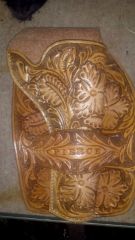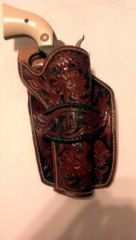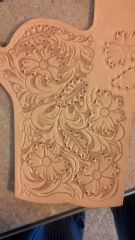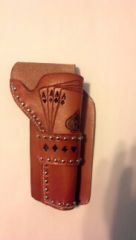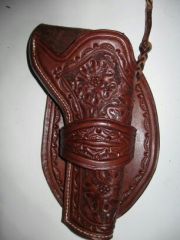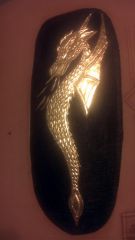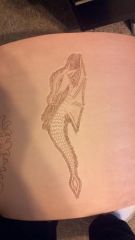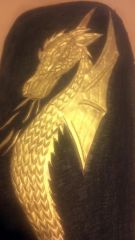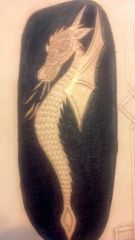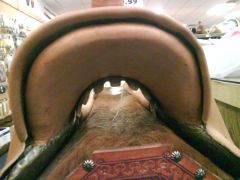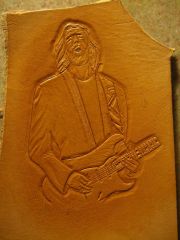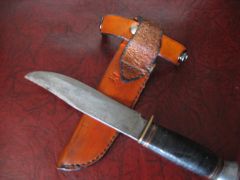
Skidder
Members-
Posts
40 -
Joined
-
Last visited
Content Type
Profiles
Forums
Events
Blogs
Gallery
Everything posted by Skidder
-
From the album: Holsters
-
A couple thoughts. If I'm doing something that I will only make a couple of, I use poster board to make the pattern and then trace around it. If it's a one time good deal, I use plastic tracing film like you can find at Tandy. If it's something I want to make a lot of then you can get plexiglas, cut it on a bandsaw or by hand then sand the edges smooth. It has less tendency to shift when tracing around it. If you use some around 1/8" thick, you can dampen your leather, put down the plexi then tap around the edges to leave an impression to cut along, trace around it, or simply cut along the plexi.
-
I do a lot of tooling and there's no substitute for practice. Duh. When laying out any pattern, I usually draw it on tracing film first then transfer it once I like what I see. Cheaper than putting it on good leather first. I used to copy patterns and go that route, but found in doing so, my stuff looked a lot like everyone elses. At that point, there's nothing to compel anyone to buy mine if someone can do it faster and better for less....usually embossed instead of hand tooled. The basic process I follow when laying out designs whether on a saddle or other object is to start with determining the size and type of flower. Once I have it figured out, I decide how far apart I want them. On saddles and other items with more space, I generally keep the space for the vines between the flowers to about half the width of the flower itself. So if the flower is 2" across, the space between is around 1". I want the flower to stand out more. By putting more space, the vines start to look busy and you lose the flower among them. For a belt, or something like a billet, you're talking repetition. For larger spaces, I like to mix things up. Regardless of which one, I then determine where the stem attaches to the flower. Using a sine wave, much has to do with the spacing. The wave should cross in the center between the flowers finishing at the bottom near the first and top of the next. I determine the size of the leaves on the vine and adjust the line to allow me to finish them on both sides. Some turn towards the top and some towards the bottom. For thinner leaves then he wave swings higher and lower so it's closer to the edges. For wider leaves and thicker stem, then it's further away so when I finish a leaf near the edge, there's room for it. When I draw it out, I start with a series of arcs coming off of the sine wave. These represent the inside shape of the individual leaves and then I go back and start at the tip making arcs towards the main line to fill in the spaces and outline the rest of the leaf. The reason I go this route is The inside of the leaf generally ties into the outside of the one before it and where there's transition. It's easier for me to visualize how I want it to tie in at that point. If I want it to look like it's coming from behind the previous leaf, it ties in at an angle like the tip is only showing. If I want it to look like it's separate and distinct, the arc from the top of the leaf below flows seamlessly into the arc of the inside of the leaf above where it ties into the stem. This allows me to adjust how full the pattern appears and how much space there is. From there it's just a matter of repeating the pattern. I don't know if there's a rule of thumb for space to the rest and think it's a matter of personal taste and has a lot to do with how well you tool. I've seen some tooling where more sapce makes the rest really stand out. I've seen some like in Sheridan style where the masters are so good they can get away with little space, but the quality of what you see is so good it stands out. Going deep and adding dimension and detail versus shallow and flat looking. The finish will add shadows and such that really make the design pop, particularly when tooled deep. When you go shallow then not so much. So if your tooling is really well done and deep, you may get away with less space but designs that stand out more than one that's shallow with a lot of space and a dyed background. Bill Gardner and Clinton Fay have a good book on Sheridan Style carving with belt examples that's really good. It shows various approaches to laying out the design and different patterns that incorporate other features that's very useful. It also has pictures of how they lay out the patterns and the tooling process. I go with what works for me and what I like so order is very indivual as far as beveling, stamping, backgrounding, etc. It does give good insight into how flowers are places for smooth transitions and such.
-
Okay, how about a pattern for a dog muzzle?
Skidder replied to VonFuct's topic in Patterns and Templates
Just had to post. I'm also looking for a muzzle pattern. A good friend is a professional trainer for search and rescue dogs as well as personal protection types. They're for police and other agencies. There is a place for them in training and it's definitely not a lack of knowledge on her part. It's also not abusive, or inviting trouble, or even laziness and a case of not knowing how to train. There's also an element of training the dog to accept the muzzle, not just slap it on and turn it loose. So to post generic one size fits all statements about whether or not they're appropriate or what the owner should be doing is a bit odd. However, a pattern would be nice to have. As it stands it looks like I'll have to make one off of one she already has. As far as crate training, you shouldn't use the wire type crates for a number of reasons. Being very close friends with a number of vets, there's an issue with collars, paws, and other things getting hung up in the wire that can be as damaging or more so than a muzzle. Crate training isn't a matter of just containing the pet. You want to use a crate that has most of three sides completely enclosed such as some of the plastic models you see out there with just the door that allows a view of the world. If you insist on using a metal cage type, then it should be covered on top and three sides with towels or other material. The goal is to create a den for the dog. By keeping most sides and the top covered, the dog feels safe and secure in its den. If you leave them open, then they simply feel trapped and unable to escape or see what's approaching from all sides at once. This can make it worse. I have a blue heeler mix that has separation anxiety and if left alone more than a couple hours, he tears apart everything he can get to. By gradually introducing him to the crate, including some food, toys and other comfort type items, he will detect me getting ready to go somewhere and go into the crate/kennel without me saying a word and wait for me to close it up. He then stays there without any issues until I get back. It's security, not containment that holds the magic. Anyway, a pattern would still be nice, but it doesn't appear anyone has one so I guess I'll be making my own. -
Thank you very much. The nice thing about working with leather is being able to do it more than once and hopefully learning/improving as you go along. I can't remember who said it, but there's a good quote, "If I ever think I built the perfect saddle, I'll quit. At that point I'm either a liar or a fool."
-
-
I've seen various methods posted, but the one I worked out is as follows: 1. Carve leather 2. Oil 3. Dye background and paint with gold leaf paint - Done in case any tears develop, it won't be as noticable, but I think the paint alone looks cheesy (opinion) 4. Put on at least one coat of Neat-Lac to seal (lacquer) 5. Apply size to area you want the gold, avoiding puddles. (gilding glue available at Hobby Lobby) 6. Apply gold leaf (used imitation here. Available at Hobby Lobby as well). 7. Top coat with Neat-Lac I found that using a camel hair brush to blot down the leaf worked well and allowed me to remove excess in the process. Did a good job getting in tooling. Hope this helps.
-
-
-
From the album: Leather gilding
© © leatherworker.net
-
-
From the album: Leather gilding
© © leatherworker.net
-
From the album: Leather gilding
© © leatherworker.net
-
From the album: Leather gilding
© © leatherworker.net
-
-
Interesting version of the San Carlos border on your saddle stand. I haven't seen that stamp before. Is it a special one, or a regular San Carlos that you went over the top of with a flower type stamp? Looks slick. I noticed you run your fork cover back almost to the cantle. Do you leave it like that or trim it? I haven't seen it done that way and wasn't sure if you use it as a riser before doing the ground seat, or just a matter of preference. Do you use an all leather ground seat, or metal strainer?....since I'm being nosey.
-
From the album: First Portraits
-
-
From the album: First Portraits
-

.jpg.d60258221c476480a6e073a8805645bb.jpg)
